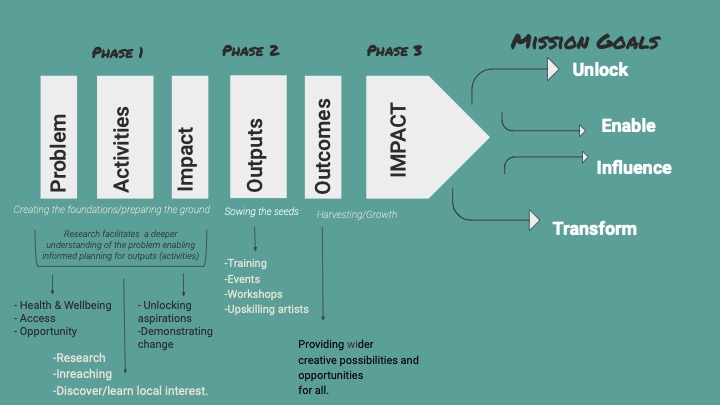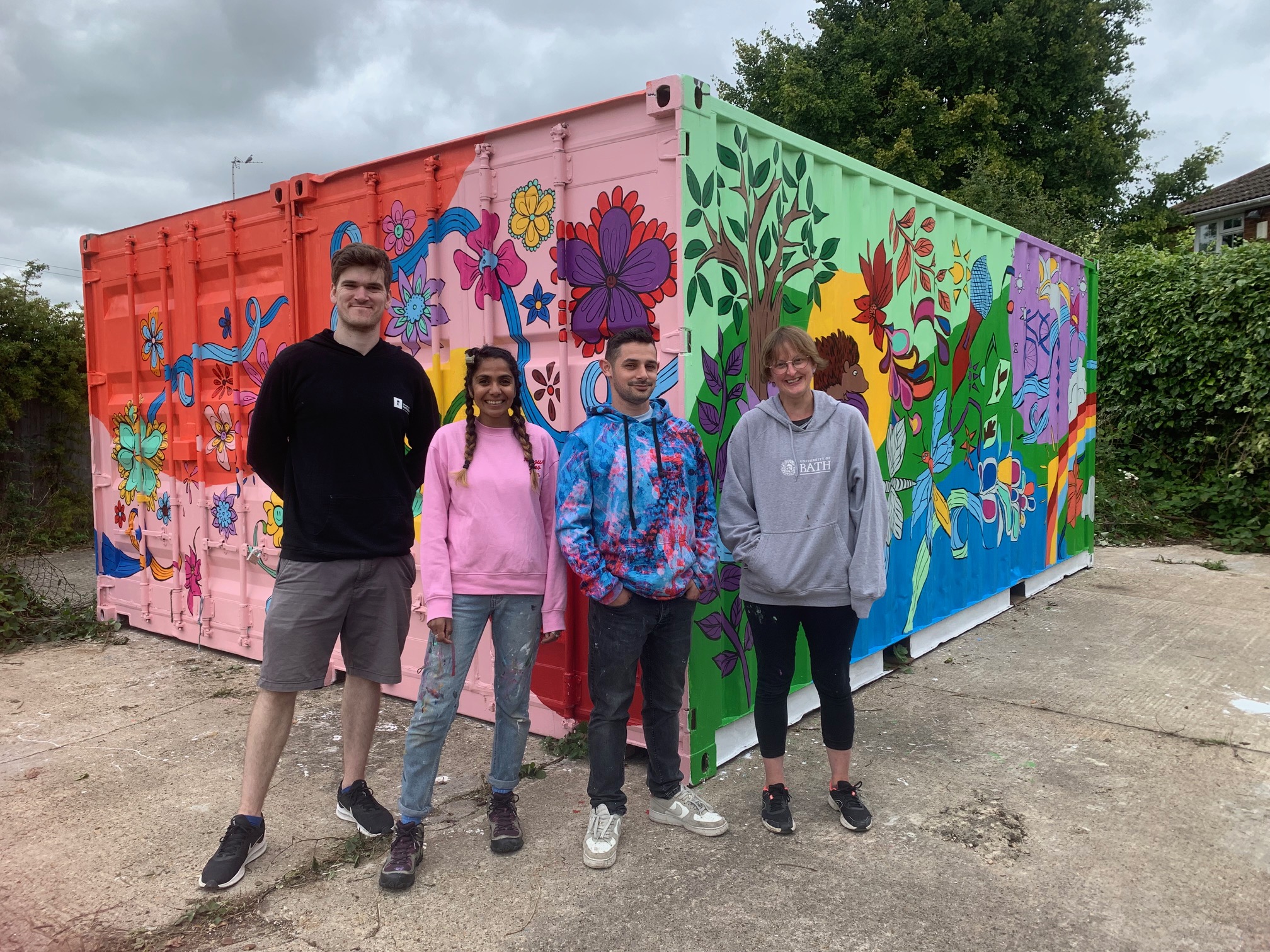Makespace Oxford South Abingdon Arts & Culture Project by Dionne Freeman
Dionne Freeman, Arts Manager at Makespace Oxford, explores The Abingdon Arts & Culture Project, a regenerative arts project designed to unlock the skills and knowledge of local residents and community groups.
The South Abingdon Arts and Culture Project offers an alternative approach to how space can be used to unlock informal arts education at any age, using the arts as a vehicle for connection and communication to transform attitudes and spaces, making public art along the way.
Makespace Oxford is a not-for-profit that reanimates empty and underused buildings into affordable, community-driven places. By opening the possibilities within communities through space, we are simultaneously lifting the lid on the social value of creative space.
The South Abingdon Arts and Culture Project is based out of our Abingdon hub, The Charter Studios, with a focus on responding to the health and social inequalities in South Abingdon. The project, funded and supported by South & Vale District Councils through the UK SPF E6 fund, explores the potential of informal arts training and skills sharing between local artists, organisations, community groups and schools. Most importantly, the impact of transferring and celebrating these creative approaches within their community is generating an awareness of the right to access creativity as a life skill.
What if we considered that the creative talent we need to create a vibrant place already exists locally, it just needs the conditions to grow and be nurtured? (Umberto Crenca, 2016).
Starting points, drive
In Abingdon, we are fortunate to have a local museum and a range of local cultural organisations. How these resources reach everyone in the community – and an awareness and confidence to access them – laid the foundations of this project. There is a position of privilege in accessing museum and gallery spaces, knowing the benefits for wellbeing, creative inspiration and stimulation is not something everyone in the community has; there has to be a purpose, a function, so we asked ourselves ‘How can arts and culture be used as tools for change? How can we weave art, community belonging, community wealth building and place making together to transform thinking?’ Through these questions we developed the project into three main strands: 1. Training artists, 2. Residencies and mentoring, 3. Exhibitions and public artwork, including an exhibition at Abingdon Museum.
Public art commissions are frequently offered to artists from outside the local area, which leads to a disconnect between the community and the art in their environment. We proposed public art that had a deeper and more embedded approach and meaning, creating an exciting opportunity of a socially and environmentally driven professional arts development programme. This regenerative arts project aimed to unlock the skills and local knowledge of residents and community groups to empower and connect them to the Abingdon landscape; generating artworks created with and by the group collaborators; made with and driven by the South Abingdon community. This enables local creatives to share skills and for Makespace to provide spaces for creative aspirations and employment, reaching those in the community who might not otherwise have accessed the arts the first time around.
We took the core values and guiding principles of Makespace Oxford to anchor and steer the work, enhancing the local landscape of what is possible.

Figure 1 South Abingdon Arts & Culture Project Theory of Change
We asked ourselves key questions to ensure the work was responding to need rather than opinion. We believe that the expertise of the work needed to unlock the potential of projects held by the community. This also requires an intervention or catalyst to spark a change and ignite aspiration as referenced by Moulaert et. al(2010):
Most of them have been initiated in reaction to conditions of social exclusion or the absence of existential quality of life […] all of them discovered early on that it would not work if their network did not include partners from ‘elsewhere’, connected to agents and institutions active at higher spatial scales than the local. And virtually none of them could be sustained without at least some form of partnership with the state, or some other formal institutional system, that enabled the creation and sustained the operation of socially innovative initiatives (Moulaert, Swyngedouw & Gonzalez 2010:2).
The right to access arts and culture lies at the heart of this project. We are primarily concerned with how creative approaches can extend and build capacity, providing the right to access arts education, and facilitating capacity to empower individuals, and in turn, communities.
The arts are an essential tool for helping us understand the human experience. They provide insight into different perspectives and experiences, generating empathy and solidarity. Because creative and expressive arts can transcend cultural, linguistic, and economic barriers they have long been used as a vehicle for social change (Goessling 2021: 59).
Story
The project began with an in-reaching approach, finding artists through street play events, who perhaps didn’t consider themselves as artists. Starting the conversation on creativity and space in an approachable way was essential in breaking down barriers and opening doors to an arts dialogue.
The first phase of the project involved transforming a bike lock-up through a mural (Figure 2).

Figure 2. Ride Revolution Bike Lock Pictured with support artist Tom Mclean, lead artist Saroj Patel, support artists Jordan Vanderhyde and Sarah Keenan
The design process engaged local youth groups, a secondary school and local residents to design something that was uplifting and celebrated the local surroundings and nature. The trainee artists worked with professional artist, Saroj Patel to understand how to approach a mural, and through training sessions they learnt how to translate their interests and skills into a deliverable piece of public art to be shared with others.
Throughout the programme we held ‘Inspiration Days’ which enabled our trainee artists to learn different approaches and techniques through workshops, and where we delved deeper into the possibilities of working in the arts. These sessions were opened up to the wider community and organisations including local MIND, Keystone, One Planet Abingdon and the Connections team, plus local Abingdon artists to spread and embed creative delivery in Abingdon. We also offered talks about how the arts and arts practice can offer ways of imagining alternative careers and viewpoints providing participants with new perspectives on what is possible in their community, and equipping them with tools to visualise those possibilities and celebrate the positives in the existing:
The work of social change begins with trying to understand the world in which people already live. Only then can we see possibilities of responding to that reality […] By helping people engage in community art practices together, not only can they regain an awareness of their own poietic capacity, but they also can find new forms of being together, types of association that aid in reviving the sense of community itself (Levine & Levine 2011:28)
During the second phase of the programme, the trainee artists worked as lead artists, and the workshops were carefully scaffolded with delivery and mentoring alongside. The artists taught at a residency at the local Children’s Centre; these spaces were about empowering parents to take the lead, creating a nurturing space for parents and children that has a focus on wellbeing and health through creativity.
The current (third) phase has a focus on partnerships that have been developed throughout the project, embedding collaboration and ensuring the sustainability of the work through upskilling and connecting existing groups. In this way we use informal arts training sessions and mentoring to offer the local community a platform to educate, engage, respond and connect. For example, the trainee artists taught in a local primary school to share skills with staff and students on site specific responses to themes of heritage, space and place. Following the recent residency, teachers at the school have already painted another mural, and through the demonstration of both the artists and the artwork created, the school now has plans for creative transformations around the site.
During the Easter holidays we created a series of arts interventions where we worked with other organisations to transform green spaces and inspire creativity and play. We are also developing ‘pavement play’ and collaborating with the local nature trails encouraging residents and visitors to celebrate their local landscapes. Jess, South Abingdon trainee support artist, explains the impact this has on individuals as well as communities:
Before the project began, I’m not sure I would have used the term ‘artist'. It has opened up new directions within my business, and now I hope to move into the new year offering sustainable workshops for not just adults but young people and children.
There are no words to truly sum up how amazing this has been. The uniqueness of bringing other creatives together and having that new support system is incredible, then to see how we are all developing.
Future aspirations for the project are to build awareness of Climate Change, Spacial and Climate justice by continuing to weave the threads of how this has and can be educated through the arts. Also, we will continue the extensive partnership work that has strengthened community cohesion and raised the perception of a community that has been profiled as ‘deprived’, by celebrating the achievements of the vibrant, diverse and rich community of South Abingdon. We have achieved this through delivering 63 community workshops so far to 1480 participants and employing 8 Abingdon based artists.
Find out more about the project here. We'd love to hear your feedback! Send us your thoughts or find out how to collaborate on future projects by contacting [javascript protected email address]
Thanks to community of South Abingdon, all the amazing artists we have worked with, Vale of White Horse and South Oxfordshire District Councils, The Abingdon Bridge, Thameside Primary School, Abingdon Museum, DAMASCUS Youth group, Active Communities, The Abingdon Bridge, One Planet Abingdon, Mental Health Natters, Keystone, The Carousel Family Centre.
About the author
Dionne has worked in community arts and education for over 20 years. Her work over the last decade has focused on accessibility; using the arts to enable new approaches, attitudes and transformative learning. With experience of working in a range of educational settings, community groups and ages, sharing skills and facilitating projects for people to express themselves and communicate through the visual arts, specialising in spatial and self-awareness.
References
Crenca, U. (2016). Who sets the agenda in America’s new urban core? Creatiz.uk: The research report. Published May 2, 2016.
Kristen, P. Goessling, Dana E. Wright, Amanda C.Wager, Dewhurst. M, (2021) Engaging Youth in Critical Arts Pedagogies and Creative Research for Social Justice: Opportunities And Challenges of Arts- Based Wok and Research with Young People, Routledge New York & London.
Levine, EG, & Levine, SK (2011). Expressive Arts Therapy and Social Change, Jessica Kingsley Publishers, London.
Moulaert, F, Swyngedouw, Gonzalez, S. (2010) Can Neighbourhoods Save the City?: Community Development and Social Innovation, Taylor & Francis Group, Oxford.